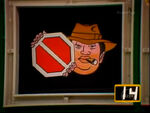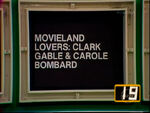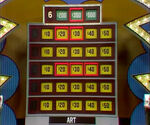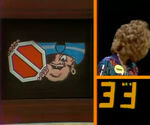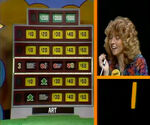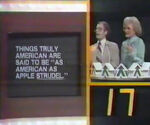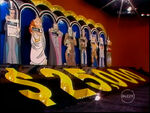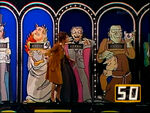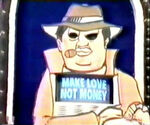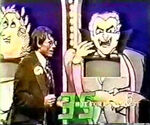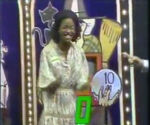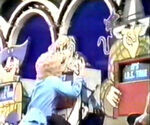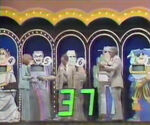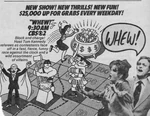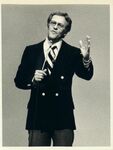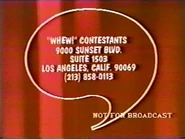| Host | |
| Tom Kennedy | |
| Announcer | |
| Rod Roddy | |
| Broadcast | |
| Pilots: 12/3-4/1978 CBS Daytime: 4/23/1979 – 5/30/1980 | |
| Packagers | |
| The Bud Austin Company (1978–1980) Jay Wolpert Productions (1979?–1980) Burt Sugarman, Inc. (1980) | |
Whew! (later known as Celebrity Whew!) was the cult favorite where two contestants charged by correcting weird sentences known as "Bloopers", block the other person, and get by an assembly of wacky Villains for $25,000.
Gameplay
Main Game
The game was played in up to three rounds. In each round, the contestants faced a six level game board. The first five levels have five hidden bloopers worth $10 to $50 (in $10 increments), and the sixth level on top had only three hidden Bloopers worth $200, $350, and $500 respectively. All the Bloopers hidden on the board were under a specific category. One contestant played the "Charger" who stood behind a weird green arrow podium, while the other player played the "Blocker" who stood behind a mean red stop sign podium.
At the beginning of each round, the Charger was sent backstage out of sight and out of hearing allowing the Blocker to replace Bloopers with blocks on the board. The Blocker's job was to place six blocks anywhere on the board but with two limitations: The Blocker could place no more than three blocks on each of the first five levels, and only one on the sixth level.
Once the blocks were placed, the Charger came back on stage. The object for the Charger was to charge his/her way up the board in 60 seconds by correcting one blooper in each level. On each level, the Charger called out a money amount to expose a Blooper which host Kennedy read in its entirety. A typical Blooper would go like this: "General Armstrong Custer was defeated by Sitting Bull in the infamous battle of Little Bugle Horn." (The answer to the blooper would be "Big".) If the Charger could correct the Blooper, he/she won the money amount that was there and moved up to the next level. If the Charger couldn't correct the Blooper, he/she stayed on that level and went to another Blooper. The charger also moved up to the next level if he/she went through all the Bloopers without correcting a single one. If at some point the Charger uncovered a block, he/she had to wait out for five seconds (by virtue of having the audience chant "4, 3, 2, 1"), the Blocker would also win the money attached to the exposed block. The blocks were held by the bonus game villains. If the Charger could make it to the top before time ran out, he/she won the round; if time ran out, however, the Blocker won the round.
If at any point the Charger felt that he/she was not going to make it to Level 6 in time, all he/she had to do is yell "LONGSHOT!" which stopped the clock and caused the Charger to jump directly to Level 6. On a Longshot, the Blocker pressed one of three secret buttons on his/her podium to place a secret block on the top level, and it could be in addition to a previously placed block on the same level. The Charger then selected one of the three Level 6 dollar amounts to play for. If the Charger found and corrected a Blooper, they won the amount chosen and won the round. But if the Charger did not correct the Blooper, or if he/she found one of the two blocks, the Blocker won the round (plus the amount attached to either block, if found).
Round 1
In Round 1, Tom would announce two categories for the first & second boards (one for each board); the challenger (or the winner of a coin toss in case of two new players) would decide to either charge or block on the first category.
Round 2
In Round 2, the roles were reversed meaning that the Charger became the Blocker and the Blocker became the Charger.
Round 3 (Tiebreaker)
If both players each won one round, the third and final round was played. In this round, Tom announced one last category for the tiebreaker board, and the champion (or the loser of a coin toss in case of two new challengers) now decided to either charge or block.
Last Weeks Rules
In the final weeks of the show, the rules were changed so that every show would end evenly. If a contestant won the first two rounds, the final round would be played by the game's winner only. The blocks were now placed randomly by computer (presumably the bonus game villains). Should the player win that round, he/she won additional money (and bonus seconds).
The first player to win two out of three rounds won the game, kept the money (maximum of $2,250), and earned the right to face the Gauntlet of Villains for $25,000 in cash.
The $25,000 Gauntlet of Villains
In the Gauntlet of Villains, the winning contestant faced 10 villains (aka the most cantankerous cads, notorious nogoods, demented derelicts, baddest bullies, zealous zenophobics, licentious lackeys, ospentacious ogres, spaced-out spartans, tragic comic book traders, lackluster lackeys and black-hearted brigands (to name a few) that ever stood between a game show champion and his/her money).
The player's job was to get pass all ten villains within the time limit by correcting Bloopers which were now listened to instead of shown. The champion started with 60 seconds and received one additional second for every $100 won in the game (Ex: $1,230 gave the champion 12 seconds added to the basic 60 seconds making a total of 72 seconds to beat the villains).
On each villain, host Kennedy read a Blooper and the contestant had a small amount of time to correct it. If the contestant couldn't correct the Blooper, the correct answer would be shown on that villain's "telly-belly" and the contestant had to stay on that villain, but if he/she did correct the Blooper, that villain's arm would drop, and the contestant moved on to the next villain. Each villain passed was worth $100, and getting past all ten before time ran out paid the champion $25,000.
Names of Villains
- Alphonse the Gangster
- Bruno the Headsman
- Mr. Van Louse the Landlord
- Nero the Fiddler
- Count Nibbleneck the Vampire
- Frank and his little friend Stein
- Kid Rotten the Gunslinger
- Jeremy Swash the Pirate
- Dr. Deranged the Mad Scientist
- Lucretia the Witch
If the contestant did not win the $25,000, he/she returned to play the next game as the returning champion; but if the champion did win the $25,000 (and seeing that this was CBS' winnings limit at the time), he/she retired from the show. By August, players also retired from the show if they won five games in a row. This was due to Howard Wilson's seven-match winning streak in June, during which he won $32,750.
Celebrity Whew!
On November 5, 1979, up until its cancellation date, the show changed formats to incorporate celebrities into the show. There were still contestants playing except that the contestants and celebrities worked together as teams and sharing jobs to win money for the contestants. When blocking, one of the players placed the first three blocks while the other player placed the last three. In the Gauntlet of Villains, one member of the team took the first half of the Gauntlet and the other took the second half.
Gallery
Press
Ticket Plugs
Rating
Music
Inventor
Studio
CBS Television City, Hollywood, CA
Trivia
The format of correcting statements would later be reworked into the question round on the Disney Channel game show Mad Libs, and the bonus round of the 2004 game show Balderdash.
The entirety of Whew! is completely intact, as Burt Sugarman owns all the episodes.
Some of the show's sound effects were later used in the 1988 game show Blackout.
Some of the show's bonus round sound effects were later used in the 1990 game show Rodeo Drive.
This happened to be the first game show Rod Roddy announced.
Additional Page
Links
Jay's Whew! Page
ClassicGameShows.com: Whew! (created by Whew! champion Randy Amasia)
Game Show Utopia: Whew!
YouTube Videos
Intro
A portion of an episode with Carrie Fedora winning $25K with 15 seconds left!
Steven LaBlang's Big Win
Series Finale


